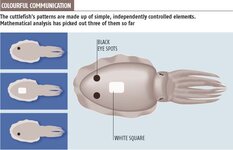I could not find this in our archives so I thought I might be post-worthy:
Mathematics reveals the cuttlefish's wink
Colourful communicationThe remarkable visual vocabulary of cuttlefish, which change the colour of their skin in a flash for communication or camouflage, is being catalogued with the help of a mathematical technique borrowed from signal processing.
Independent component analysis (ICA) was invented to untangle mixtures of signals. For example, it can pick out individual voices from the babble of a crowd.
Now cuttlefish expert Daniel Osorio and his colleagues from the University of Sussex in Britain are hoping it can help them work out which basic elements cuttlefish use to build up their sophisticated patterns. They called in neuroscientist John Anderson, also at Sussex, to help as they photographed a cuttlefish (Sepia officinalis) swimming around in a tank.
The patterns on cuttlefish's backs change as they try to camouflage themselves, or when they are startled. "They are quite emotional little animals," says Anderson. "If you just walk into the room they can get quite panicked."
Black eye
The team obtained 30 clear pictures of the patterns. As all were taken at slightly different angles, the researchers used a mesh of reference points to convert each image into a plan view of the animal's back.
They then used specialised ICA computer software to study the images. The technique looks for elements within the images that change independently of one another between pictures, and assumes these are the building blocks used to create the patterns.
So far the team has found three such elements (see diagram) - two black eye spots that are displayed towards the back of the cuttlefish when it feels threatened, and a white square that appears on the middle of the body. The cuttlefish can control each independently, explains team member Roland Baddeley. "They have this neat behaviour where they can 'wink' one of these eyes to let you know they are there," he says.
No assumptions
Although the eye spots and the square have been noted before, this is the first time that they have been picked out using a purely mathematical analysis, that makes no prior assumptions about the nature of the signals.
"Now we can put numbers on the properties," says Baddeley. And now they are confident that the technique works, the researchers are hopeful that they will be able to identify other, less obvious components.
ICA will not be able to tell the whole story, though. According to Baddeley, the technique distinguishes patterns that can be turned up and down like a dimmer switch. But cuttlefish have a second repertoire of all-over body patterns, such as stripes and spots, that are either on or off.
Journal reference: Network: Computation in Neural Systems (vol 14, p 321)
Mathematics reveals the cuttlefish's wink
Colourful communicationThe remarkable visual vocabulary of cuttlefish, which change the colour of their skin in a flash for communication or camouflage, is being catalogued with the help of a mathematical technique borrowed from signal processing.
Independent component analysis (ICA) was invented to untangle mixtures of signals. For example, it can pick out individual voices from the babble of a crowd.
Now cuttlefish expert Daniel Osorio and his colleagues from the University of Sussex in Britain are hoping it can help them work out which basic elements cuttlefish use to build up their sophisticated patterns. They called in neuroscientist John Anderson, also at Sussex, to help as they photographed a cuttlefish (Sepia officinalis) swimming around in a tank.
The patterns on cuttlefish's backs change as they try to camouflage themselves, or when they are startled. "They are quite emotional little animals," says Anderson. "If you just walk into the room they can get quite panicked."
Black eye
The team obtained 30 clear pictures of the patterns. As all were taken at slightly different angles, the researchers used a mesh of reference points to convert each image into a plan view of the animal's back.
They then used specialised ICA computer software to study the images. The technique looks for elements within the images that change independently of one another between pictures, and assumes these are the building blocks used to create the patterns.
So far the team has found three such elements (see diagram) - two black eye spots that are displayed towards the back of the cuttlefish when it feels threatened, and a white square that appears on the middle of the body. The cuttlefish can control each independently, explains team member Roland Baddeley. "They have this neat behaviour where they can 'wink' one of these eyes to let you know they are there," he says.
No assumptions
Although the eye spots and the square have been noted before, this is the first time that they have been picked out using a purely mathematical analysis, that makes no prior assumptions about the nature of the signals.
"Now we can put numbers on the properties," says Baddeley. And now they are confident that the technique works, the researchers are hopeful that they will be able to identify other, less obvious components.
ICA will not be able to tell the whole story, though. According to Baddeley, the technique distinguishes patterns that can be turned up and down like a dimmer switch. But cuttlefish have a second repertoire of all-over body patterns, such as stripes and spots, that are either on or off.
Journal reference: Network: Computation in Neural Systems (vol 14, p 321)

